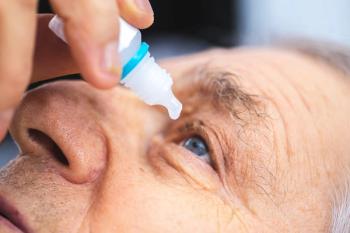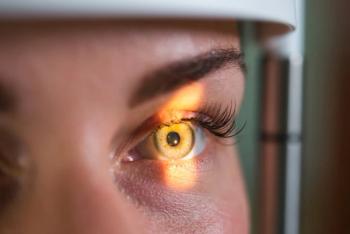
- September/October digital edition 2025
- Volume 17
- Issue 05
Neurotrophic keratitis in focus: Diagnosis, treatment, and practice pearls
NK is more common than recognized; early diagnosis is paramount.
Francis Mah, MD, joined Lauren McLoughlin, OD, in conducting a recent Optometry Times Insights discussion on recognizing neurotrophic keratitis (NK) using corneal sensitivity testing and patient history. They discussed differentiating NK from other ocular surface diseases and treating patients with cenegermin-bkbj ophthalmic solution (Oxervate; Dompé) and supportive therapies.
Mah is an ophthalmologist specializing in advanced corneal, cataract, and refractive surgery at Scripps Clinic in La Jolla, California, serving as its director of cornea and external disease. Mah is also president of the American Society of Cataract and Refractive Surgery. McLoughlin is an optometrist at Clear Advantage Vision Correction Center in Portsmouth, New Hampshire.
NK diagnosis
Because NK mimics dry eye disease, McLoughlin noted that she differentiates them based on the patient’s chief complaint and medical history. However, Mah and McLoughlin emphasized the need for corneal sensitivity testing to identify corneal desensitization as quickly as possible.
Corneal sensitivity testing has become a regular component of McLoughlin’s initial dry eye workup. She said that she uses it in routine eye care, based on patients who describe photophobia and blurred vision and have a history of diabetes and glaucoma treatment.
When evaluating corneal sensitivity, Mah said that he uses a cotton-tipped applicator. McLoughlin uses both a cotton-tipped applicator and the Brill noncontact esthesiometer, which she said is more quantitative and offers 5 sensitivity levels, facilitating more precise staging and monitoring of NK.
Conjunctival staining patterns are also helpful for pinpointing dry eye rather than NK, because the latter shows corneal staining without significant conjunctival involvement. “Regardless of the method used to test corneal sensitivity, the key message is the importance of testing,” Mah said.
The importance of early diagnosis of NK cannot be overstated, because it is a chronic progressive disease, McLoughlin said. “Stage 1 is easier to treat than stage 3. Identifying those patients earlier will result in substantially better outcomes,” she added.
Three red flags in the diagnostic process are a history of herpetic infection, diabetes, and treatment with glaucoma medications, McLoughlin noted. “When a patient has stain and no pain, that is a typical characteristic of NK,” McLoughlin said. The presence of filamentary keratitis is another classic presentation of NK: Patients with filaments usually have desensitized corneas, she said.
NK management
For patients with stage 1 NK, the easiest to treat, McLoughlin uses an amniotic membrane. However, in the event of recurrent superficial punctate keratitis, she uses cenegermin-bkbj as her go-to therapy, due to its track record of healing in approximately 70% of patients in clinical trials.
For patients with stage 2 NK, she may use an amniotic membrane and a bandage contact lens, but she also uses cenegermin-bkbj. Stage 3 NK can require comanagement with a cornea specialist, and tarsorrhaphy may be the treatment approach, but some patients do well with cenegermin-bkbj, McLoughlin said.
Mah said he believes that application of amniotic membrane has become more useful, because cenegermin-bkbj may not be readily available. He also mentioned serum tears, which are useful after treatment to maintain the ocular surface. He described the effects of cenegermin-bkbj as “impressive” and has been incorporating the drop into his practice to treat patients with stage 1, 2, or 3 NK. “It works, especially in these difficult-to-manage [cases]. I have been happily surprised at the drug’s accessibility. The biggest positive factor with the drug is its durability of effect, because NK tends to recur. Most patients who healed stayed healed,” Mah said.
For patients who finish the 8-week, 6-times-daily instillation of cenegermin-
bkbj but have not been completely healed, McLoughlin uses an amniotic membrane. In other cases, she may prescribe a low-dose steroid, such as 0.25% loteprednol, for 2 to 3 weeks. For patients with dense NK that has been present for 2 to 3 years, she has repeated cenegermin-bkbj and reported that patients did well with the redosing.
It is vital for these patients, according to Mah, to support the ocular surface with dry eye treatments such as cyclosporine, avoid drops with preservatives, instill serum tears, and closely follow up with patient education.
Managing NK in the presence of comorbidities
Glaucoma, contact lens wear, and diabetes can be confounding factors in patients with NK, according to Mah and McLoughlin.
For patients with glaucoma, the goal is to minimize the amount and exposure to preserved drops. Contact lens wearers may be reluctant to discontinue their lenses in the short term during treatment, but wearing them may contribute to ocular surface changes. Following treatment of NK, the shift from a soft lens or extended-wear lens to a rigid gas-permeable lens or a scleral lens may be beneficial for ocular health, Mah pointed out.
For patients with diabetes, controlling their disease and avoiding treatments that contain preservatives are paramount to prevent further nerve damage and complications. McLoughlin emphasized that the cornea has the most nerves in the body, and corneal neuropathy can occur in patients with diabetes.
Articles in this issue
about 1 month ago
Reflex for stabilizing vision develops without sensory inputabout 1 month ago
The emerging era of presbyopia-correcting eye drops: What’s next?about 1 month ago
Lens-based refractive surgery is carving out a growing nicheabout 2 months ago
So you want to create a private label eyewear brand?about 2 months ago
Study establishes reference data set for GA lesion progressionabout 2 months ago
What a pharmaceutical representative taught me about glaucoma drops2 months ago
Top-line DEWS III updatesNewsletter
Want more insights like this? Subscribe to Optometry Times and get clinical pearls and practice tips delivered straight to your inbox.









































